The ASUS ROG Strix G15 (G513QY) Review: Embracing AMD's Advantage
by Brett Howse on May 31, 2021 11:00 PM ESTSystem Performance
The ASUS ROG Strix G513QY features the AMD Ryzen 9 5900HX processor, which is near the top of the Ryzen 5000 range. With eight cores, sixteen threads, and a 4.6 GHz peak frequency, this Zen 3 powered processor offers a rated 45-Watt TDP, compared to the 35-Watt in the 5900HS. It is also overclockable, if you want to tweak performance a bit more. For a full deep-dive into the latest Ryzen 5000 series, check out Ian’s article where he tested the 5900HS in-depth.
Compared to the outgoing Ryzen 4000 series “Renoir”, the Ryzen 5000 series “Cezanne” moves from Zen 2 to Zen 3 cores, and is still built on TSMC’s 7 nm process. Instructions-per-clock is up, and thanks to the process, the per-core efficiency is quite high. AMD chose to stick with the Vega 8 graphics, even on the 45-Watt chips, and while not ideal on the 15-Watt U-Series chips, the GPU is mostly irrelevant in this class, as most 45-Watt CPUs tend to be paired with dedicated graphics. That is the case here, with the AMD Radeon RX 6800M.
Thanks to the coupling of the AMD CPU and GPU, the ASUS Strix G513QY gets to take advantage of the shared power and AMD SmartShift. When the GPU is not active, the CPU can use up to 90 Watts of power, or up to 54 Watts sustained when the GPU is active. The GPU has a rated sustained power limit of 145-Watts, but can be increased up to 15% by leveraging some of the CPU’s power limit if it is not needed.
Memory on the unit is dual-channel DDR4-3200, with 16 GB in the review unit, but up to 32 GB available from ASUS. As this is a gaming laptop, the DDR4 will be in removable SODIMMs, allowing owners to upgrade their memory if they want.
To see how the system performs, it was run through our laptop suite. To compare the ASUS ROG Strix G513QY to any other system we have tested, please use our online bench tool.
PCMark 10
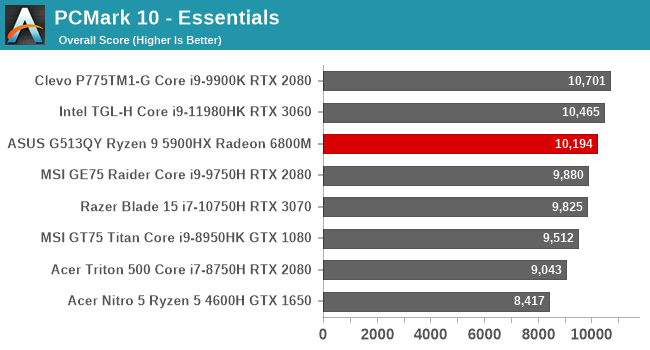
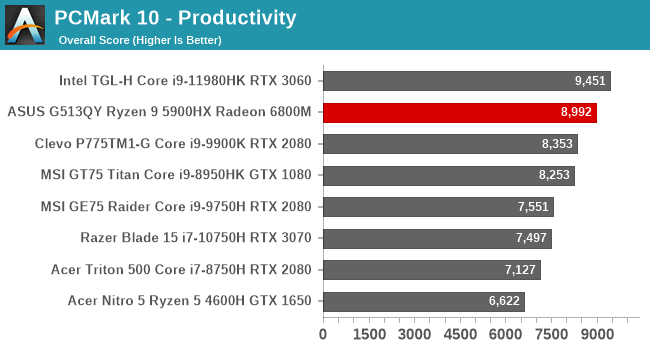
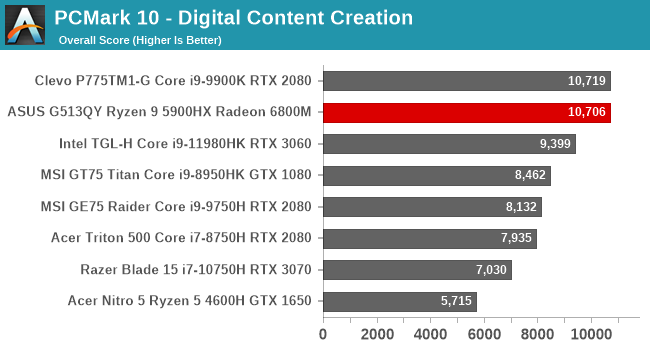
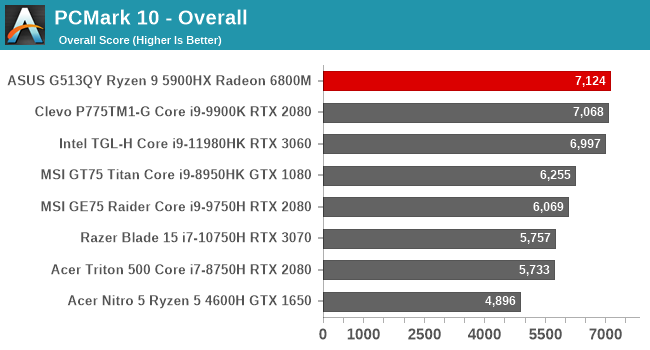
UL’s PCMark suite is a comprehensive benchmark tool which stresses all aspects of a system. In the overall suite, there are three sub-categories each focusing on different aspects of the system. The Cezanne powered ASUS G513QY is slightly behind the Intel reference system with the latest Tiger Lake-H processor in the CPU-related tasks, but the grunt of the Radeon RX 6800M GPU pulls it up significantly in the Digital Content Creation subcategory, which bumps the ASUS up to the very top of the list on the overall combined score.
Cinebench
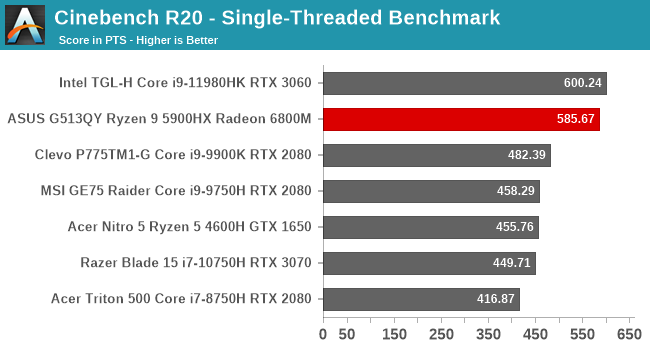
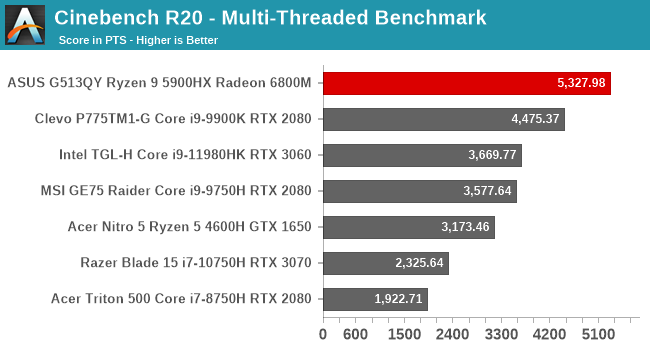
As a purely CPU test, Cinebench allows choosing between a single-thread workload, or multi-threaded, which is useful for many reasons. In terms of single-threaded performance, the Cezanne APU blows past the Skylake-based laptops, and the Zen 2 Ryzen 5 as well, but it is behind by just a hair compared to the latest Tiger Lake processor. But, thanks in part to TSMC’s 7 nm process, and the efficiency of the Zen 3 core, when all sixteen threads are active, the Ryzen 9 spreads its wings and takes off. It is a huge gap, even compared to the Clevo which is outfitted with a desktop-class 95-Watt processor. Part of the AMD advantage is that the system is able to dedicate more power to the CPU when the GPU is not active, and that clearly helps in this scenario.
Handbrake
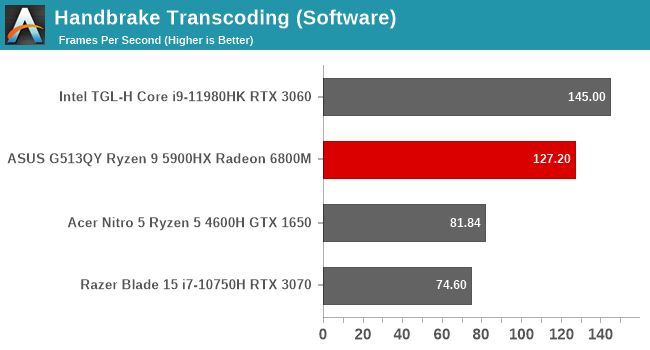
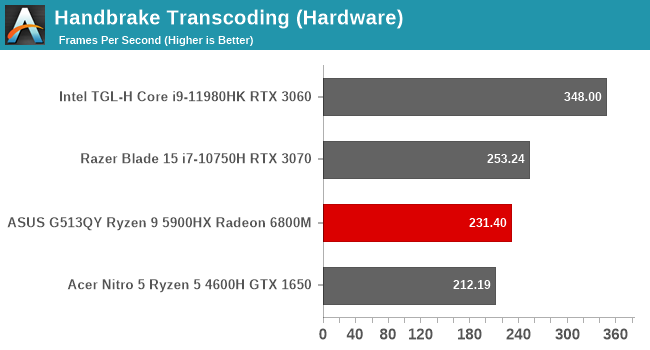
Likely the most popular video transcoding tool around, Handbrake offers the choice to perform the transcode on the processor, or on the fixed-function hardware in the media block. Software encoding will give the best results, even at the same quality settings, but if you just need to transcode something quickly and are not as concerned about the end product, AMD offers VCE, Intel offers QuickSync, and NVIDIA offers NVENC options to accelerate the workload. In terms of software encoding, surprisingly the Tiger Lake H laptop was able to nudge out the ASUS G513QY, and the AMD’s VCE solution is not as quick as NVIDIA’s media block at this test.
7-Zip
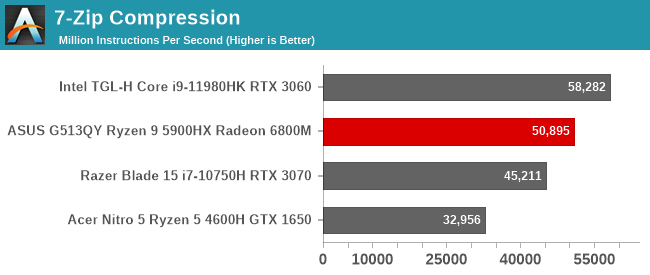
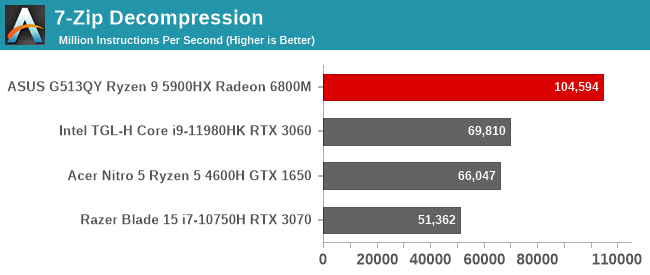
Another common tool is 7-Zip for file compression and decompression, and the utility includes a built-in benchmark which measures both. On the compression side, the Cezanne APU was edged out by the Core i9-11980HK, but on decompression, AMD’s processor is significantly quicker.
Web Tests
Web performance is not just a CPU test, but also a browser test, since web performance is predicated on the underlying browser scripting engine. For all tests, we leverage Microsoft Edge, although any benchmark result is a point in time, since browsers are constantly updated which may impact the results.

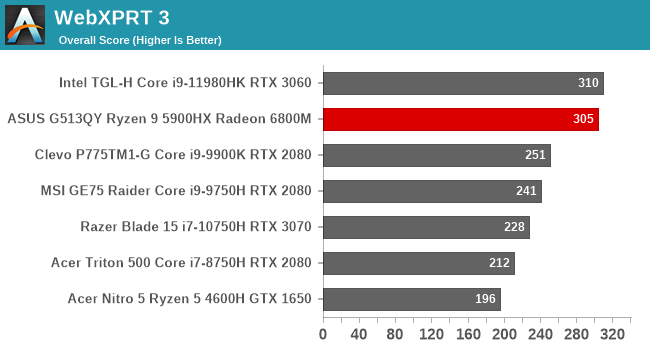
Although Cezanne comes a long way here, it is still slightly behind Tiger Lake in terms of web performance. Much of this comes down to the single-thread performance of the processor, and AMD’s efficiency advantage does not come into play, as the system will not be anywhere near its TDP.
Storage Performance
One of the newer additions to the laptop testing suite is PCMark 10’s storage benchmark, which uses real-world traces in its workloads, simulating overall drive performance much more accurately than a simple bandwidth test. With Cezanne, AMD has stuck with PCIe 3.0, despite offering PCIe 4.0 on their desktop chips, whereas Intel has moved to PCIe 4.0 with Tiger Lake. The review unit of the ASUS Strix G513QY features the Samsung PM991, which is a PCIe 3.0 x4 NVMe drive. The system also has a free M.2 slot, for future expansion.
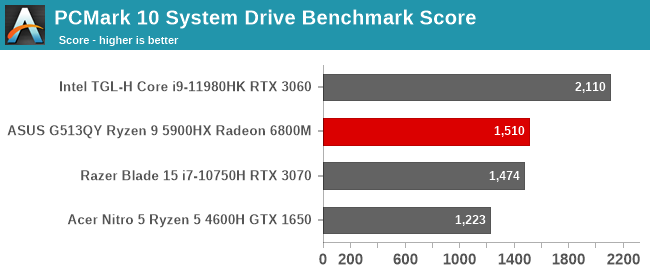

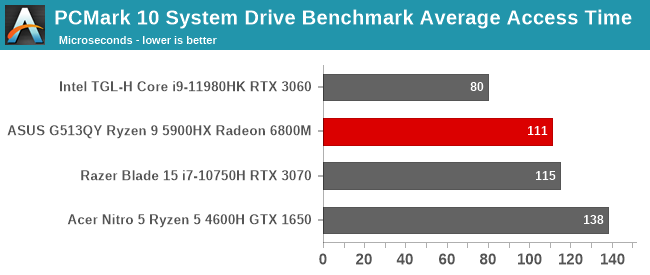
Although the drive can’t compete with the PCIe 4.0 drive in the Intel reference system, the Samsung PM991 does perform well in this benchmark. Compared to the other PCIe 3.0 systems we have tested, this one was at the top.











146 Comments
View All Comments
WaltC - Friday, June 4, 2021 - link
I'm almost positive I read the laptop offers an HDMI and DP (USB-C) output, for external monitors/TVs one would presume--too bad the reviewer here forgot to test a 1440P external monitor--which is likely considering the target market for this monitor. The reviewer kept talking about the absence of a web cam and a limit of 1080P (which doesn't exist) as if either was an insurmountable design flaw--oh, gee, I guess thinking just a little bit out of the box is difficult for people these days. He could have tested with an external monitor at > 1080P--and if he looked hard enough he might even have found one with a built-in web cam. Do tell. But that would have prevented the negative observations, I guess--so we can't have that, eh? BTW, 1080P is nice indeed when you are running on batteries--but I guess that was a bit too obvious to get his attention. Many, many people with laptops plug them into the wall at home and attach monitors/TVs/ whatever else they might want. No sense in writing a review which pretends otherwise.bejito81 - Tuesday, June 1, 2021 - link
why is this not compared with a RTX G15 (3070 or 3080 (the one matching the price the closet)) ?Ryan Smith - Tuesday, June 1, 2021 - link
AMD only sampled the AMD system. They did not sample the NVIDIA systems.Spunjji - Monday, June 7, 2021 - link
It matches a 3070 most closely in pricing, performance sits in the range of high-TDP 3070 models and low-to-medium-TDP 3080 models. Apparently it's held back a little by RAM that has slow timings - with that resolved, it's right up there with the 3080.yeeeeman - Tuesday, June 1, 2021 - link
Nice review, but I would have liked to see a bit more details on the GPU side of things, that is some 4k comparisons with rtx 3080, since that is the target competitor.I look forward to see how the 6600m fares. If that is similar or better than 3060, I could give it a shot.
Alistair - Tuesday, June 1, 2021 - link
actually the AMD laptop is cheaper than the 3070 version, it beats all in performance per dollarET - Tuesday, June 1, 2021 - link
Nice to see AMD back in the game. For the keyboard, I have one of these ASUS laptops (with a 3080) for work, and the position of the F keys really annoys me. As a programmer I use them quite a bit, and because they're shifted by 1 for the first four (F1 is above 2, F2 above 3, etc.) and half for the next four, I keep hitting the wrong one.Anyway, I'm really looking forward to seeing what the 6600M brings to the table, and if it could provide reasonable gaming performance on battery with a bit of battery life. A smaller gaming laptop that's still reasonably capable would be very nice.
ads295 - Tuesday, June 1, 2021 - link
I love this thing to bits.I wish there was a way to control the charge rate though, since pushing that crazy amount of power through the battery cannot be good for the long term. I guess you can limit the charge rate by using USB-PD but 100W means you can only slow down the discharge of the battery rather than actually charge it...
Amazing product. ASUS' work on the cooling system is commendable too. Up till now I've seen that they do not compromise on size if they feel it will affect the cooling performance. Now they've delivered cooling performance even after downsizing.
As an aside, my sisters' ASUS FX553VD suffered two major hardware issues during her ownership for which the authorised service outlet asked for INR50k+ to fix. I luckily found a guy who does low level repair and we managed to avoid buying a new laptop. Hopefully that was a solitary incident...
supdawgwtfd - Tuesday, June 1, 2021 - link
Get a 65w charger.No more worries about "to faster charging"..
You know that technology improves over time right?
It might be strange but things get better over time...
What used to be "oh my this is really bad" is now "it's fine".
ads295 - Tuesday, June 1, 2021 - link
Using a 65W charger on a system that draws over 230W at the wall?